What's New
Displaying results 3481 - 3490 of 4914
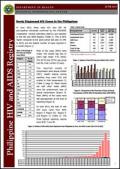
Resource | Fact Sheets,
In June 2013, there were 431 new HIV Ab sero-positive individuals confirmed by the STD/AIDS Cooperative Central Laboratory (SACCL) and reported to the HIV and AIDS Registry (Table 1). This is 46% higher compared to the same period last year (n=295 in 2012) and the highest number of cases reported in a month.
Most of the cases (95%) were males. The median age was 27 years (age range: 4-61 years). The 20-29 year (57%) age group had the most number of cases.

Resource | Guidelines,
These consolidated guidelines provide guidance on the diagnosis of human immunodeficiency virus (HIV) infection, the care of people living with HIV and the use of antiretroviral (ARV) drugs for treating and preventing HIV infection. They are structured along the continuum of HIV testing, care and treatment. Behavioural, structural and biomedical interventions that do not involve the use of ARV drugs are not covered in these guidelines.
The 2013 consolidation process combines and harmonizes recommendations from a range of WHO guidelines and other documents, including the following 2010 guidelines on using antiretroviral therapy (ART) for HIV infection in adults and adolescents, in infants and children and for treating pregnant women living with HIV and preventing HIV infection in infants. Comprehensive guidance is now provided on using ARV drugs across age groups and populations of adults, pregnant and breastfeeding women, adolescents, children and key populations. The guidelines also aim to consolidate and update clinical, service delivery and programmatic guidance.

Resource | Publications,
The United Nations Global Compact, as the world’s largest corporate sustainability initiative, was asked to assess and report on the views of business leaders on global sustainability priorities, and specifically how business can contribute to advancing and achieving these goals in a post-2015 context.
Following a globe-spanning series of consultations, surveys and focused discussions held over the past year with thousands of companies and investors, it is clear that businesses committed to responsibility and sustainability are energized by the prospect of a newly articulated set of world priorities – which include clear goals and targets – and by the interest shown by the United Nations Member States and the United Nations Secretary-General in incorporating the view points and capabilities of the private sector. The United Nations post-2015 agenda presents the opportunity to shift to a new paradigm in development thinking by fully recognizing the central role of business.
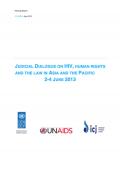
Resource | Laws and Policies,
The Judicial Dialogue provided a critical opportunity for experience sharing between members of the judiciary and representatives of judicial training institutions from 16 countries across Asia and the Pacific, on the complex legal and human rights issues raised by the HIV epidemic. The Judicial Dialogue also benefited from the perspectives of people living with HIV, representatives of communities of men who have sex with men, transgender people, sex workers and people who use drugs.
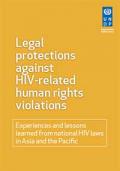
Resource | Publications,
The UN Political Declaration on HIV/AIDS (2011) reaffirmed that the full realization of human rights and fundamental freedoms for all is an essential element in the global response to HIV. The enactment of laws to protect the human rights of PLHIV and key populations at higher risk of HIV is essential to creating an enabling environment for effective HIV responses. The UN Economic and Social Commission for Asia Pacific (ESCAP) Resolution 66-10 (2010) calls on member states to ground universal access to HIV services in human rights and to address legal barriers to HIV responses, and ESCAP Resolution 67-9 (2011) commits states to initiate reviews of national laws, policies and practices to enable the full achievement of universal access targets with a view to eliminating all forms of discrimination against PLHIV and key affected populations.
This study is intended to inform the efforts of governments and civil society to strengthen the enabling legal environment for HIV responses. The focus is both on the content of protective laws and issues that arise in effective implementation of protective laws. Ensuring protective legislation is in place is insufficient – attention must also be paid to how the law is implemented and enforced.

Resource | Publications,
The overly broad application of criminal law to HIV non-disclosure, exposure and transmission raises serious human rights and public health concerns. Because of these concerns, the Joint United Nations Programme on HIV/AIDS (UNAIDS) urges States to (i) concentrate their efforts on expanding the use of proven and successful evidence-informed and rights-based public health approaches to HIV prevention, treatment and care, and (ii) limit any application of criminal law to truly blameworthy cases where it is needed to achieve justice. States should strengthen HIV programmes that enable people to know how to protect themselves from HIV and to avoid transmitting it, and they should help people access the services and commodities they need for HIV prevention, treatment, care and support.

Resource | Publications,
The Panel came together with a sense of optimism and a deep respect for the Millennium Development Goals (MDGs). The 13 years since the millennium have seen the fastest reduction in poverty in human history: there are half a billion fewer people living below an international poverty line of $1.25 a day. Child death rates have fallen by more than 30%, with about three million children’s lives saved each year compared to 2000. Deaths from malaria have fallen by one quarter. This unprecedented progress has been driven by a combination of economic growth, better policies, and the global commitment to the MDGs, which set out an inspirational rallying cry for the whole world.
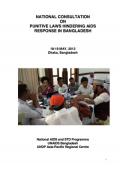
Resource | Laws and Policies,
The objectives of the workshop were to identify the laws hindering the AIDS response and build consensus on reforms needed to create an enabling legal environment for access to HIV services and to chalk out a time bound action plan identifying priorities for the amendment of punitive and discriminatory legal environment that are impeding AIDS responses.
The consultation was attended by 82 participants. The inaugural session, which was attended by eminent personalities, expressed the need for the timely intervention, while the overview of the HIV/AIDS epidemic in Bangladesh painted a vivid picture to the participants in understanding the gravity of the AIDS epidemic and limitations of the current response.
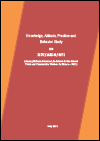
Resource | Publications,
This study has shown that there is a high level of general HIV Knowledge among three out of four populations studied. Use of Intravenous drugs appears to be very low, and this was observed for all population studied. Of particular interest is the results obtained as part of this study showing between 1-13% reported IDU users in a study carried out in 2009 which is different to that found in this study. Whether that is truly the case or not will be evident in future studies and possible youth focused KABP studies.






